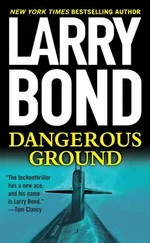“XO, we can’t sink a RIB, at least not with small arms. I’ve been on boats very similar to the Iranian models. Those things use closed cell foam in their hulls. They’re almost impossible to sink,” observed Lapointe.
“Who said anything about sinking them, Pointy?” Jerry replied with a smile. “Our target is one of the outboard engines. We take out an engine and he’s out of the game.”
“What you’re suggesting makes a lot of sense, XO. But dealing with the DShK heavy machine gun will be crucial. Even on a small boat it has a serious range advantage over our best weapon,” Ramey stated thoughtfully.
Jerry was relieved to see that Ramey had swiftly recovered from the initial shock of Michigan’s abrupt departure. They had all been flabbergasted, overwhelmed when they realized Guthrie couldn’t send help. But the platoon leader had rebounded quickly and was dealing with their problems, not just agonizing over them.
“Yes, Matt. On paper a.50 caliber machine gun has, what?… about twice the range of Harry’s sniper rifle?”
“More or less, usually more, it depends on the specific model. But when mounted on a small boat the effective range drops by about a third,” Ramey replied.
“Well, this isn’t your basic paper drill; we’re at sea and that changes everything,” said Jerry.
“How so?” asked Ramey.
“When I was at postgraduate school, I read a lot about the Navy’s research into the Iranian small boat swarm-attack problem — lots of small boats mobbing one of our own ships, a destroyer or cruiser. The Navy’s been putting.50 caliber machine guns and 25-millimeter cannons on our ships, because they concluded the larger five-inch and three-inch guns were too easily overwhelmed and didn’t handle small boats that were in close. But even with these smaller, fast-firing weapons, accurate engagement ranges was well inside eight hundred yards, and those Iranian patrol boats are a lot smaller than a destroyer.
“We are both in fast-moving, bouncy boats, with unstabilized guns, aimed by a Mark 1 Mod 0 eyeball. And the IRGC trains to attack big lumbering targets, not nimble little speedboats. I’d be surprised if they could hit us at more than two hundred yards under these conditions. They’ll have to get really, really close to score any hits. And at those ranges, I’ll bet on your marksmanship over theirs any day of the week.”
“Well, I’m glad to see we’re good for something,” Phillips quipped.
“Just drive, Phillips,” chastised Ramey, then he said more seriously, “Okay then, here’s the basic plan: XO, you take on the navigation issue and figure out the best course to close the RIB. My guys and I will do what we can to protect Dr. Naseri and prepare for the fight. Any questions?” There weren’t any. “Then back on your heads, people.”
The collective brainstorming session had buoyed their confidence; the situation wasn’t completely hopeless once it was broken down. With renewed assurance that they had a fighting chance, the SEALs began preparing with gusto. While Jerry worked out the best course to take to close on the RIB, Ramey and Lapointe looked at ways to prevent the enemy from doing to them, what they planned to do to him — take out an engine. At the same time, Fazel concentrated on finding a way to give Shirin some protection from at least small-arms fire.
It took Jerry only a couple of minutes to do the math, and he ordered Phillips to change course twenty degrees toward the west. If his mental gymnastics were correct, things would get really interesting in about ten minutes.
8 April 2013
0540 Local Time/0240 Zulu
Twenty Nautical Miles South-Southwest of Bandar Lengeh
Rahim tapped his fingers on the coaming. It had been over thirty minutes since they’d left Bandar Lengeh and there was still nothing on the radar screen. Visibility had improved considerably as soon as the sun broke over the horizon, but the lookouts had spotted nothing. Agitated, impatient, and just a little green from the patrol boat’s choppy motion, the VEVAK agent was in a foul mood. “Lieutenant! You said we should have detected them by now!”
“Yes, Major, I did. However, there were a number of assumptions behind that statement. If even one was incorrect, then the estimate would have been incorrect as well.” Qorbani kept his tone respectful; this wasn’t the first time he had to deal with someone that didn’t understand the maritime patrol problem.
“Could they have gone more to the west?” demanded Rahim.
“Of course they could have, sir. But to escape Iran, they have to move away from our coast, not parallel it. Besides, such a course would send them directly toward one of our secondary bases on Kish Island. A westerly course would be foolish. Since these are not fools we are dealing with, a southerly escape course makes the most sense. There is nothing more we can do but continue on toward the intercept point and wait,” Qorbani answered.
Rahim didn’t like the lieutenant’s answer, but his explanation was logical. Frowning, he peered through his binoculars, straining to catch some sign of his prey. They have to be out here somewhere, he thought. Allah would surely not abandon him at this crucial juncture.
Suddenly, Qorbani shook Rahim’s shoulder. He turned to see the Pasdaran lieutenant on the radio. He repeated the contact report back for accuracy, as well as for Rahim’s benefit. “Understand the ten-meter RIB has contact on a high-speed craft heading south-southwest. Visual contact expected in four minutes.”
8 April 2013
0543 Local Time/0243 Zulu
Twenty-Five Nautical Miles South of Iran
Jerry leaned against the forward part of the control console and scanned the starboard side. “Nothing yet, Matt,” he reported.
“Keep looking, XO. He’s only about three miles away, broad on our starboard beam,” shouted Ramey, as he watched the UAV video feed. “Yeah, they have us on radar. One of the sailors keeps pointing in our general direction.”
Fazel had tucked Shirin as far forward in the small boat as he could. She wore one of the tactical vests and her head was sandwiched between two of the backpacks. It wasn’t much protection. A direct hit from any of the larger Iranian weapons would likely go right through, but it would provide her some shielding from splinters if the boat’s hull was hit.
At the opposite end of the boat, Ramey and Lapointe had wrapped two tactical vests around the head of the outboard engine and stacked the remaining packs along the back end. Again, the protection was minimal. A.50 caliber bullet would have no problem going through, but smaller rounds might be stopped. Ramey also set up firing positions for Fazel and himself, the goal being to limit their exposure while hopefully reducing the effects of the boat’s movement on their own shots.
Lapointe tried to assume a prone position, but the bouncing hull kept slamming into the knee on his wounded leg. And try as he might, the pain made even limited aiming impossible. Both he and Jerry would provide supporting fire from behind the console. Phillips volunteered to stay on as the driver. He and Ramey went over a basic evasive steering plan that would complicate the Iranians’ ability to hit them, but not limit their field of fire. Being the most exposed, Phillips wore the last vest. After a short discussion, it was decided that Jerry would be the backup driver in case Phillips was wounded and incapable of steering the boat.
“Tallyho!” shouted Jerry. “Contact just abaft the starboard beam!” He made repeated motions with his arm, pointing in the general direction of the Iranian patrol boat.
Ramey raised his scope and swiftly confirmed the sighting. “Got it, XO! Okay, everyone, take your positions.”
Читать дальше












